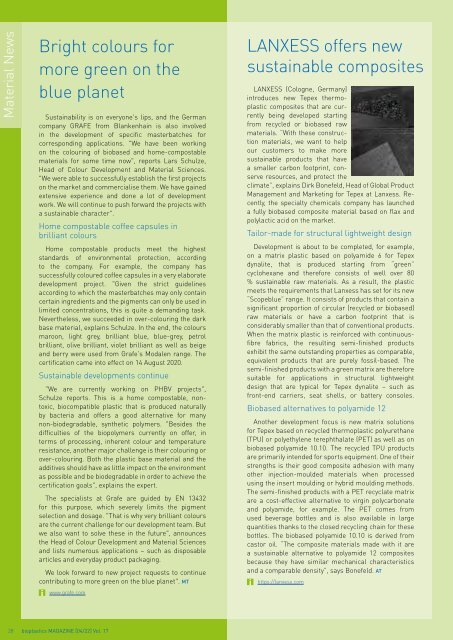Issue 04/2022
Highlights: Blow Moulding / Bottle Applications Polyurethanes / Elastomers Basics: FDCA & PEF
Highlights:
Blow Moulding / Bottle Applications
Polyurethanes / Elastomers
Basics:
FDCA & PEF
You also want an ePaper? Increase the reach of your titles
YUMPU automatically turns print PDFs into web optimized ePapers that Google loves.
Material News<br />
Bright colours for<br />
more green on the<br />
blue planet<br />
Sustainability is on everyone's lips, and the German<br />
company GRAFE from Blankenhain is also involved<br />
in the development of specific masterbatches for<br />
corresponding applications. "We have been working<br />
on the colouring of biobased and home-compostable<br />
materials for some time now", reports Lars Schulze,<br />
Head of Colour Development and Material Sciences.<br />
"We were able to successfully establish the first projects<br />
on the market and commercialise them. We have gained<br />
extensive experience and done a lot of development<br />
work. We will continue to push forward the projects with<br />
a sustainable character".<br />
Home compostable coffee capsules in<br />
brilliant colours<br />
Home compostable products meet the highest<br />
standards of environmental protection, according<br />
to the company. For example, the company has<br />
successfully coloured coffee capsules in a very elaborate<br />
development project. "Given the strict guidelines<br />
according to which the masterbatches may only contain<br />
certain ingredients and the pigments can only be used in<br />
limited concentrations, this is quite a demanding task.<br />
Nevertheless, we succeeded in over-colouring the dark<br />
base material, explains Schulze. In the end, the colours<br />
maroon, light grey, brilliant blue, blue-grey, petrol<br />
brilliant, olive brilliant, violet brilliant as well as beige<br />
and berry were used from Grafe's Modalen range. The<br />
certification came into effect on 14 August 2020.<br />
Sustainable developments continue<br />
"We are currently working on PHBV projects",<br />
Schulze reports. This is a home compostable, nontoxic,<br />
biocompatible plastic that is produced naturally<br />
by bacteria and offers a good alternative for many<br />
non-biodegradable, synthetic polymers. "Besides the<br />
difficulties of the biopolymers currently on offer, in<br />
terms of processing, inherent colour and temperature<br />
resistance, another major challenge is their colouring or<br />
over-colouring. Both the plastic base material and the<br />
additives should have as little impact on the environment<br />
as possible and be biodegradable in order to achieve the<br />
certification goals", explains the expert.<br />
The specialists at Grafe are guided by EN 13432<br />
for this purpose, which severely limits the pigment<br />
selection and dosage. "That is why very brilliant colours<br />
are the current challenge for our development team. But<br />
we also want to solve these in the future", announces<br />
the Head of Colour Development and Material Sciences<br />
and lists numerous applications – such as disposable<br />
articles and everyday product packaging.<br />
We look forward to new project requests to continue<br />
contributing to more green on the blue planet". MT<br />
www.grafe.com<br />
LANXESS offers new<br />
sustainable composites<br />
LANXESS (Cologne, Germany)<br />
introduces new Tepex thermoplastic<br />
composites that are currently<br />
being developed starting<br />
from recycled or biobased raw<br />
materials. “With these construction<br />
materials, we want to help<br />
our customers to make more<br />
sustainable products that have<br />
a smaller carbon footprint, conserve<br />
resources, and protect the<br />
climate”, explains Dirk Bonefeld, Head of Global Product<br />
Management and Marketing for Tepex at Lanxess. Recently,<br />
the specialty chemicals company has launched<br />
a fully biobased composite material based on flax and<br />
polylactic acid on the market.<br />
Tailor-made for structural lightweight design<br />
Development is about to be completed, for example,<br />
on a matrix plastic based on polyamide 6 for Tepex<br />
dynalite, that is produced starting from “green”<br />
cyclohexane and therefore consists of well over 80<br />
% sustainable raw materials. As a result, the plastic<br />
meets the requirements that Lanxess has set for its new<br />
“Scopeblue” range. It consists of products that contain a<br />
significant proportion of circular (recycled or biobased)<br />
raw materials or have a carbon footprint that is<br />
considerably smaller than that of conventional products.<br />
When the matrix plastic is reinforced with continuousfibre<br />
fabrics, the resulting semi-finished products<br />
exhibit the same outstanding properties as comparable,<br />
equivalent products that are purely fossil-based. The<br />
semi-finished products with a green matrix are therefore<br />
suitable for applications in structural lightweight<br />
design that are typical for Tepex dynalite – such as<br />
front-end carriers, seat shells, or battery consoles.<br />
Biobased alternatives to polyamide 12<br />
Another development focus is new matrix solutions<br />
for Tepex based on recycled thermoplastic polyurethane<br />
(TPU) or polyethylene terephthalate (PET) as well as on<br />
biobased polyamide 10.10. The recycled TPU products<br />
are primarily intended for sports equipment. One of their<br />
strengths is their good composite adhesion with many<br />
other injection-moulded materials when processed<br />
using the insert moulding or hybrid moulding methods.<br />
The semi-finished products with a PET recyclate matrix<br />
are a cost-effective alternative to virgin polycarbonate<br />
and polyamide, for example. The PET comes from<br />
used beverage bottles and is also available in large<br />
quantities thanks to the closed recycling chain for these<br />
bottles. The biobased polyamide 10.10 is derived from<br />
castor oil. “The composite materials made with it are<br />
a sustainable alternative to polyamide 12 composites<br />
because they have similar mechanical characteristics<br />
and a comparable density”, says Bonefeld. AT<br />
https://lanxess.com<br />
28 bioplastics MAGAZINE [<strong>04</strong>/22] Vol. 17

















